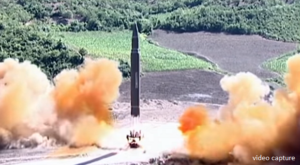 North Korea’s antics and activities have filled the news for months now, having accelerated since Donald Trump was sworn in as president.
North Korea’s antics and activities have filled the news for months now, having accelerated since Donald Trump was sworn in as president.
While their pursuit of nuclear weapons and missile technology is nothing new, the hermit kingdom of Kin Jong-un seems to be making strides in that direction.
Their latest missile test is a prime example of this. Scheduled on our Independence Day, this missile was a “present” to the United States, according to North Korea’s dictator.
This missile, the Hwasong-14, was the first truly intercontinental missile that the North Korean’s have developed, and its maiden flight went off flawlessly. After the failures of their most recent missile tests, the success of this new model has suddenly made the threat from North Korea much more real.
According to the South Korean Joint Chiefs of Staff, the Hwasong-14 missile flew over 900 miles, all of it under power. It splashed into the ocean within Japan’s exclusive economic zone, making it a real threat to the Japanese as well, another country that the North Korean government hates almost as much as it hates the United States.
But Japan is a long way from the United States, isn’t it? Yes it is, but the missile didn’t fly its full designed range, probably so that North Korea’s engineers could watch the descent and splashdown as well.
According to experts, the 37 minute flight time of the missile would have given it the ability to reach a maximum altitude of 2,800 km. That would give it a total range of 8,000 km or more, exactly what the government in Pyongyang has stated it would do.
What this means is that the North Koreans finally have a missile that has the potential of reaching the United States. Alaska, Seattle, Washington and Hawaii are all within its range, making Kim Jong-un’s oft-repeated threat of unleashing nuclear hell on the United States a real possibility for the first time.
The fact that this missile, the first of its type, performed so well on its maiden voyage is especially troubling, as it shows how much North Korea’s engineers have been learning from the failures of their recent launches. While those were not of the Hwasong-14, the lessons learned from those less-capable missile launches were obviously applied to the design and manufacture of this new one.
Essentially, this missile is an improvement on the Hwasong-12, with a second stage added. While the first three launches of the Hwasong-12 were failures, the fourth attempt, in May of this year, was a success, with the missile’s apogee 2,111.5 km above the ground and landing 787 km away in the Sea of Japan.
This leads me to think that the Hwasong-14 may actually be able to surpass the 2,800 hm altitude necessary to reach the West Coast of the United States.
What’s Next on the Battlefield?
Does this mean that thermonuclear war is going to come in the next few weeks? Probably not. But it does clearly show us that we are one step closer.
How many of these new missiles they have in production right now is a big question that remains unanswered, as well as whether their nuclear program has reached the point where their bombs are small enough to be installed on top of one of these missiles.
But it is clear that at the rate in which North Korea is improving their missile technology that it won’t be long before they are a true threat to the mainland United States. This new missile, if launched close enough to the United States, could easily carry a nuclear bomb high enough to generate an EMP that would blanket all 48 contiguous states.
Since the missile launches off a mobile launcher, rather than from a silo, this is a very real possibility. It is too large to fit into North Korea’s ballistic missile subs, but it is not too large to be ship-launched.
While too long to fit into a standard shipping container, a special container could be manufactured for it, with the launcher built in. Shipped on a North Korean freighter, this would not be noticeable by the international community.
Such a ship, armed with the Hwasong-14 and a team of technicians, could launch from the middle of the ocean, conducting an effective EMP strike. Being in the middle of the ocean would make detection and interdiction of the responsible ship difficult, but not impossible.
Even so, I am sure that Kim Jong-un would be happy to trade the lives of that crew for the destruction of the United States’ electrical grid.
GREEN ENERGY – Click Here to find out how you can build your own energy generator.
In addition, North Korea has as many as six ballistic missile submarines. While they are actually obsolete technology, their existence can’t be ignored. Each of those subs can carry up to two Pukkuksong-1 nuclear missiles.
While the range of that missile is limited to 500 km, the submarine could sneak in close to the shore, launching their missiles to take the heart out of any city within about 300 miles of the coast. Used in conjunction with the Hwasong-14, in a coordinated attack, these could add a considerable amount of punch to the attack.
Recently, I was discussing this with a friend in the military, who dismissed the North Korean’s submarine fleet as obsolete. While I have to agree with him to some extent, there is one glaring statistic which is of supreme importance in any discussion of North Korea’s submarine capabilities. That is, they have a lot of them.
Current estimates put their submarine fleet near 70, which means it would take every submarine the United States Navy owns, including our ballistic submarines to shadow them all.
What this means is that the North Koreans could swarm their submarines to sea and we would not be able to follow them all. Properly executed, there is a chance that their ballistic submarines would escape detection and therefore would not be shadowed. Should that happen, they would have a potent weapon pointed at our country.
Of course, a lot depends on what sort of attack the North Korean military would choose to hurl at the United States. While Kim Jong-un has made it clear that his intent is to attack us with nuclear arms, there are many forms that attack could take. Most specifically, it could be an EMP or a more conventional nuclear attack.
Video first seen on PBS NewsHour .
Our best chances would be if he launched a conventional nuclear attack against us. While that would probably mean the destruction of a number of our most important cities, as a nation we would survive.
But an EMP attack would take out our electrical grid, our communications and just about everything else in the country. Chances are, 90 percent of our population would die.
Currently, we have three aircraft carriers and their battle groups steaming off the Korean Peninsula, ready for anything that North Korea might do. While this constitutes a major naval force, projecting more power than any other nation’s military can project.
But it is of little use against a nuclear threat, except in the case of a disarming first strike. Should the president decide that such a strike was necessary, the combined air power of the three aircraft carriers doesn’t come close to the number of fighters available to North Korea.
Of course, our Navy’s F-16s are more advanced than the North Korean’s fighter jets, even their F-21s, of which they have about 200. Nevertheless, sheer numbers are on the side of the North Koreans, if it is decided that it is necessary to do a preemptive strike against them. Between 458 fighter aircraft and 572 attack aircraft, our 180 Navy aircraft will have a busy time of it.
Then there’s the risk of North Korea attacking our aircraft carriers with their submarine fleet, if we launch a preemptive strike. While our naval fleets always work with submarines in attendance and our nuclear-powered fast-attack boats are technologically far superior to their diesel-electric ones, the sheer numbers of submarines that the North Korean’s have available to them would make things interesting for the submarines working to defend our carrier fleets.
But the real trump card that the North Koreans hold, is the fact that their missiles are mobile. Unlike fixed locations, the missile carriers themselves would have to be located, before any attack could be made. While I’m sure that the NRO is hard at work at this task, hunting for something as small as a missile launcher, in the vastness of any country, even one as small as North Korea, is not easy.
Looking at all this together, it is clear that the threat of a nuclear-armed North Korea is a real threat. It is clear that we would win any exchange with the North Koreans. If they chose to use a nuclear-tipped missile against us, our long-standing policy would be to retaliate in kind.
While I would hate to have the responsibility to give that order, someone in the Pentagon has to be thinking about it.
Who’s Paying the Price?
Turning North Korea into a parking lot, in retaliation for destroying our country or even one of our major cities, is not an equitable bargain. We might win the war, but it would be at a terrible price in both military and civilian lives. That’s a price that we as a nation, can’t afford to pay.
So, while chances of a non-military solution are looking thinner and thinner by the day, we need to be praying and hoping for just that. The last Korean war cost approximately 1.9 million total casualties, this next one could cost many times more.
You and I need to be prepared for such an eventuality, regardless of whether it means a conventional nuclear exchange or suffering an EMP attack.
If you live in or near a major city, especially on the West Coast, I would recommend that it’s time to move. Find yourself some greener pastures elsewhere, where you would not be living in the midst of a target. If you can make that move be to a small town, where you wouldn’t have to content with the massive number of people trying to survive after an EMP, so much the better.
Either way, we have apparently just entered another Cold War, and this one seems like we are facing off against an enemy who is much less stable than the old Soviet Union was.
Chances of an actual nuclear attack are clearly much greater than they have ever been. Take the right steps to survival and prepare to face the blackout with your own energy bank! Click the banner for more!
This article has been written by Bill White for Survivopedia.
References:
http://nationalinterest.org/blog/the-buzz/north-koreas-submarine-fleet-big-threat-or-big-joke-20300
from Survivopedia
Don't forget to visit the store and pick up some gear at The COR Outfitters. How prepared are you for emergencies?
#SurvivalFirestarter #SurvivalBugOutBackpack #PrepperSurvivalPack #SHTFGear #SHTFBag


No comments:
Post a Comment